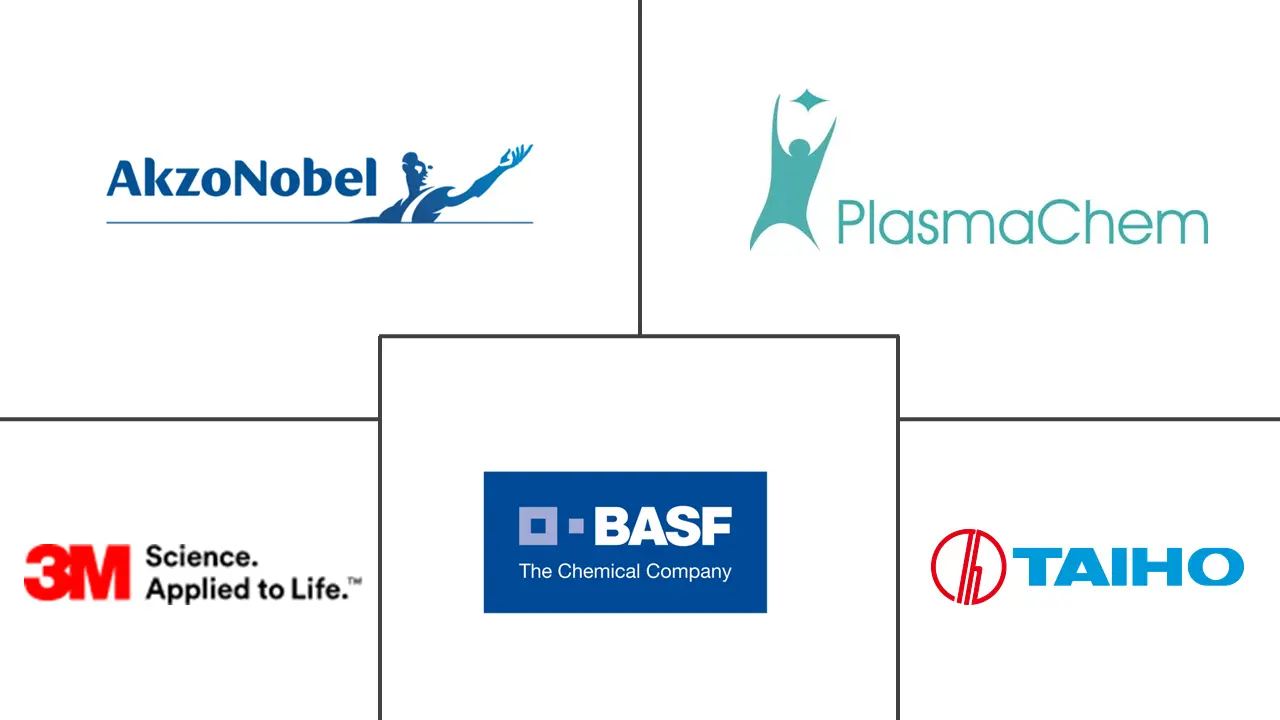Nanohybrid Composites Market Size and Share
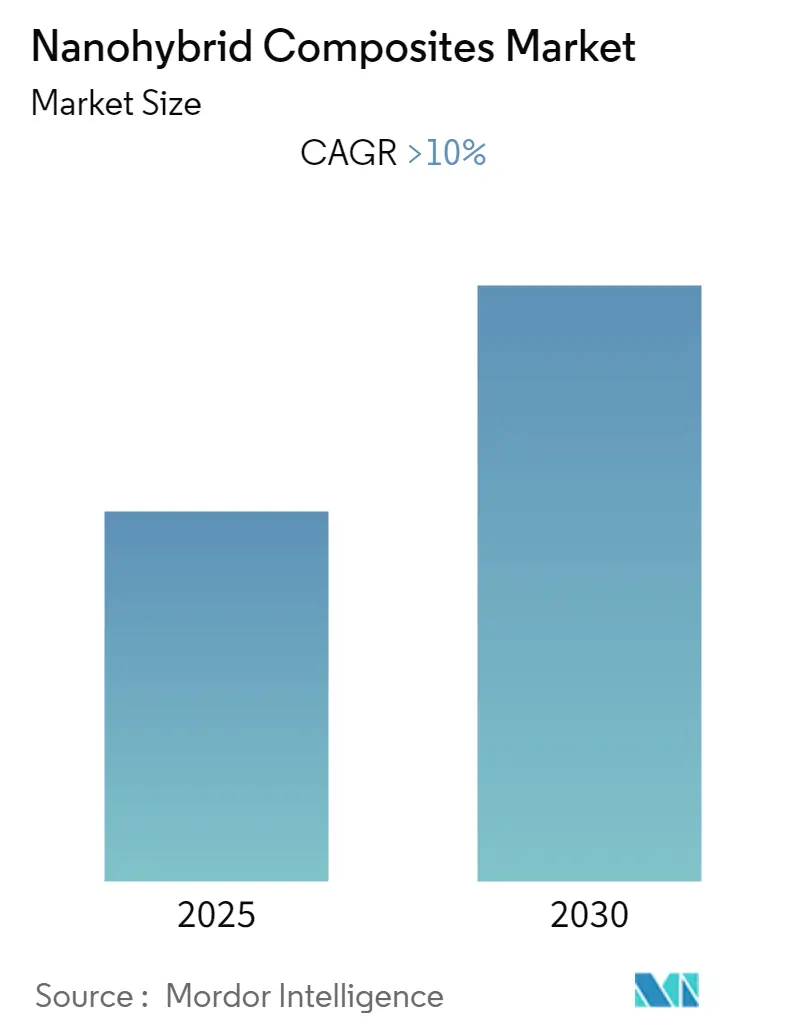
Nanohybrid Composites Market Analysis by Mordor Intelligence
The Nanohybrid Composites Market is expected to register a CAGR of greater than 10% during the forecast period.
The COVID-19 pandemic harmed the global nanohybrid composites market. The worldwide market for nanohybrid composites reached its peak before the pandemic, but it only had minimal growth in 2020 owing to the COVID-19 pandemic. Substantial growth was predicted to return in 2021 as the market for nanohybrid composites' intrinsic driving drivers remained constant. Currently, the market has recovered from the pandemic and is growing at a significant rate.
- Over the short term, the increasing usage of nanohybrid composites in the dentistry industry is driving the market over the forecasted period.
- However, substitutions like nano-filled composites are expected to have major limitations on the growth rate of the nanohybrid composites market during the projected period.
- Nevertheless, the potential uses of nanohybrid composites in many technical fields are creating new opportunities for this market segment in the future.
- The Asia-Pacific region dominated the market globally, with the largest consumption coming from countries such as China and India, and this is expected to remain the same in the future.
Global Nanohybrid Composites Market Trends and Insights
Progressive Usage of Dental Materials Rises the Demand for the Market
- Due to their use as dental materials, demand in the dental industry has pushed the market for nanohybrid composites.
- On the other hand, the dental material application segment is expected to grow significantly. Larger particles encircling nanometer-sized particles make up nanohybrids. Although the compositions of various materials differ, the purpose is the same: to create a "universal" dental composite. Nano-hybrids mix nanoscale particles with more traditional filler technologies.
- Experimental inserts for teeth were recently created using hydroxyapatite (HAp) nanoparticles to combine their bioactive potential with cosmetic restorative materials. In recent years, controlled porous biphasic hydroxyapatite/tricalcium phosphate, monophasic dense hydroxyapatite, and composite hydroxyapatite/zirconia dental inserts have been manufactured and evaluated for use as dentine replacements.
- The hardness and fracture toughness of the obtained bioceramic implants were within the range of values for human dentine. In vitro, these inserts were demonstrated to lower the polymerization shrinkage of insert-containing restorations and modify the shrinkage vectors of surrounding resin-based composites, potentially functioning as a central stress reduction.
- The most recent generation of nanohybrid composites, which were brought to the market a few years ago, combines the best of both materials to provide long-lasting restorations with a high gloss finish to the teeth. This is critical for improved esthetics and reduced plaque buildup.
- Dental nanohybrid composites using silica sand are tooth-colored filling materials used to treat cavities and other dental abnormalities, providing a long-lasting and aesthetically acceptable alternative for dental restorations.
- According to Statistics Norway, the Consumer Price Index (CPI) for dental services in Norway has risen over time. In November 2022, the index value was 130. The Consumer Price Index (CPI) for dental services in Norway climbed dramatically until February 2021.
- All the aforementioned factors are expected to drive the dental materials segment, which will also enhance the demand for nanohybrid composites during the forecast period.
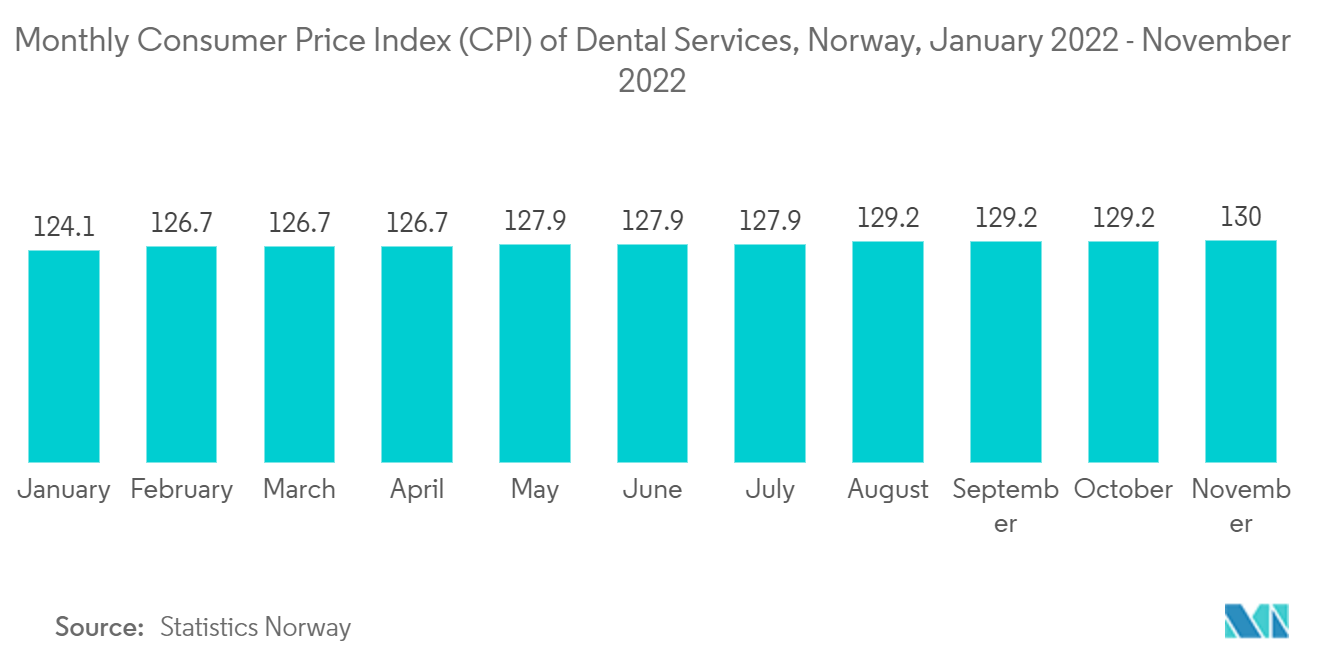
North America Region to Dominate the Market
- The global nanohybrid composites market is divided into seven geographical areas. North America has the biggest market share and will be the top user of nanohybrid composites during the projection period.
- The United States is predicted to increase at a modest rate throughout the projection period. Increasing disposable income in emerging nations is driving demand for convenience items, helping the growth of the worldwide nanohybrid composites market.
- Nanohybrid composite materials are rapidly being used in a wide range of engineering applications due to their superior features and benefits over standard composite materials. n (n > 2) cooperatively functioning phases determine the mechanical characteristics of hybrid composites. As a result, as previously stated, the mechanical characteristics of nanohybrid composites are modeled using a linear coupling of numerical simulation models.
- A variety of dental composite fillings are developed to provide dentists with essential benefits like adaptability, aesthetics, strength, and clinical confidence while performing any restorative surgery, anterior or posterior. There are a variety of nano-hybrid composite resins advanced to real nanotechnology, depending on the handling or procedure preferences. The nanocomposites provide excellent aesthetics while maintaining the control and predictability that you want in your processes.
- Microhybrids and nanohybrids used to be a substantial advance over earlier microfills. Since then, it has raised the standard with composite resins that use nanotechnology, allowing dentists to provide patients with clinically proven, long-lasting dental health and natural-looking aesthetics. Nanohybrids, like micro hybrids, feature separate big and tiny particles, but their average particle size is somewhat smaller. For general usage, but mostly on the back teeth.
- According to the American Dental Association, in 2021, the United States were expected to have 159,246 general practice dentists and 10,921 orthodontic and dentofacial orthopedic dentists. This statistic depicted the number of professionally active dentists working in the United States in 2021, organized by specialty.
- The incorporation of nanohybrids into organic coatings may improve barrier effectiveness by lowering porosity and zigzagging the diffusion path for harmful species. Consequently, nanohybrid-containing coatings are predicted to offer considerable barrier qualities for corrosion protection and to lessen the coating's tendency to blister or delaminate.
- According to the American Coatings Association, the paint and coatings industry in the United States was expected to produce around 1.36 billion gallons in 2022. In 2023, the industry's output was expected to exceed 1.38 billion gallons.
- Nanohybrid composites are used in electrical and electronic applications such as insulation, dielectric, energy harvesting, batteries, and space exploration. According to Forbes, NextEra Energy, headquartered in Florida, was the largest electric utility company in the world in 2022, with a market value of USD 145.27 billion. Duke Energy came in second with a market value of USD 105.4 billion.
- As a result, all the causes listed above are projected to increase demand for the nanohybrid composites market in the North American region in the future.
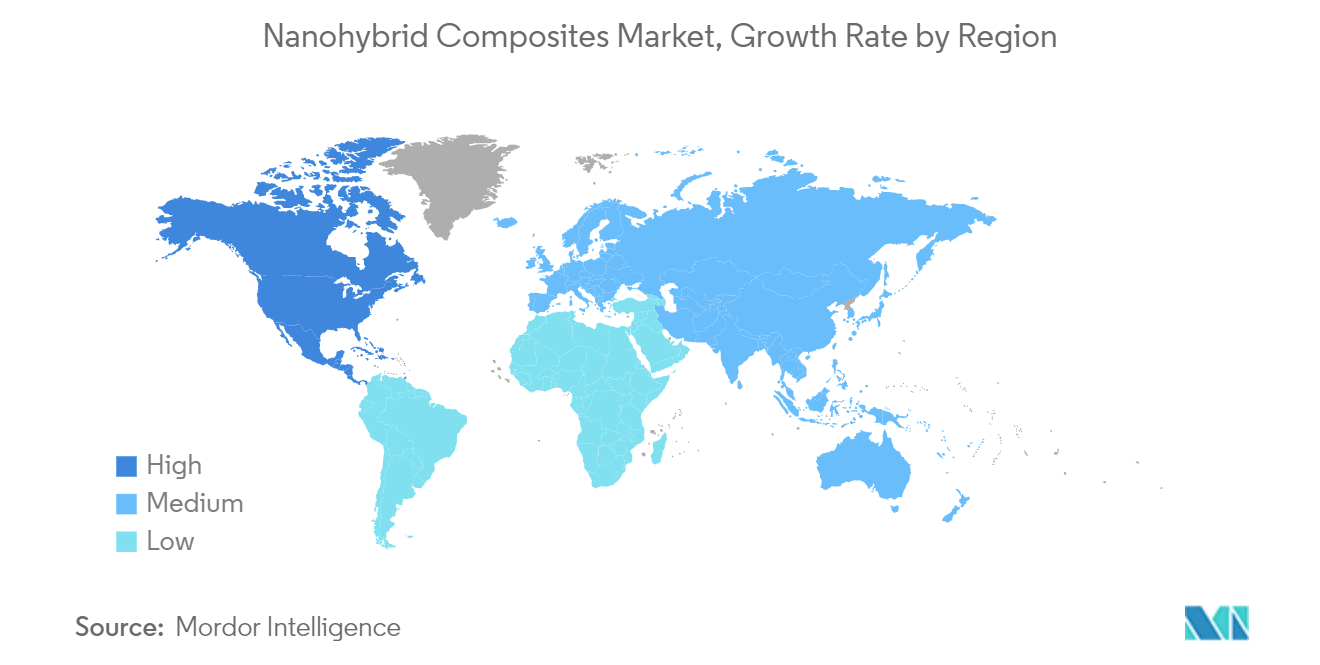
Competitive Landscape
The global nanohybrid composites market is consolidated with the presence of large-sized players and a few numbers of small players operating. Some of the major companies are 3M, Akzo Nobel N.V., BASF SE, PlasmaChem GmbH, and TAIHO Corporation amongst others (in no particular order).
Nanohybrid Composites Industry Leaders
-
3M
-
BASF SE
-
PlasmaChem GmbH
-
TAIHO Corporation
-
Akzo Nobel N.V.
- *Disclaimer: Major Players sorted in no particular order
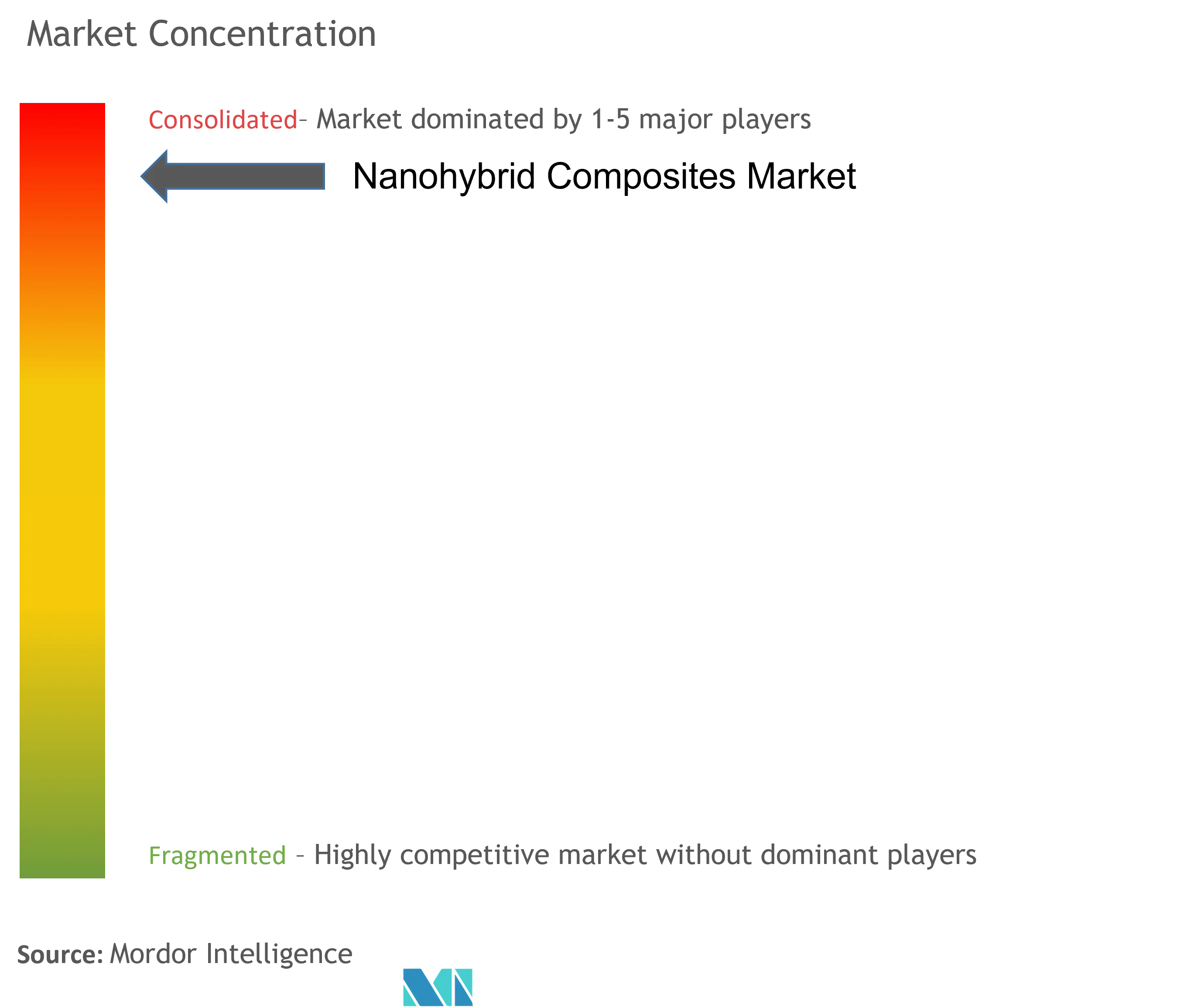
Recent Industry Developments
No recent development pertaining to the market.
Global Nanohybrid Composites Market Report Scope
Nanohybrid composites are heterogeneous or hybrid materials created at the nanometric scale by combining polymers with inorganic solids (from clays to oxides). Its structures have been discovered to be more complex than those of microcomposites.
Market segments for nanohybrid composites include geography (Asia-Pacific, North America, Europe, and the rest of the world), application, and material types. By material types, the market is segmented into silica (SiO2), titanium dioxide (TiO2), zirconia (ZrO2), carbons, and metals. By application, the market is segmented into dental materials, electrical and electronics, paints and coatings, and other applications. The report also offers market sizes and forecasts for 11 countries across major regions. For each segment, market sizing and forecasts have been done based on revenue (USD million) for all the above segments.
| Silica (SiO2) |
| Titanium dioxide (TiO2) |
| Zirconia (ZrO2) |
| Carbons |
| Metals |
| Dental Materials |
| Electrical and Electronics |
| Paints and Coatings |
| Other Applications |
| Asia-Pacific | China |
| India | |
| Japan | |
| South Korea | |
| Rest of Asia-Pacific | |
| North America | United States |
| Canada | |
| Mexico | |
| Europe | Germany |
| United Kingdom | |
| Italy | |
| France | |
| Rest of Europe | |
| Rest of the World | South America |
| Middle-East and Africa |
| Material Type | Silica (SiO2) | |
| Titanium dioxide (TiO2) | ||
| Zirconia (ZrO2) | ||
| Carbons | ||
| Metals | ||
| Application | Dental Materials | |
| Electrical and Electronics | ||
| Paints and Coatings | ||
| Other Applications | ||
| Geography | Asia-Pacific | China |
| India | ||
| Japan | ||
| South Korea | ||
| Rest of Asia-Pacific | ||
| North America | United States | |
| Canada | ||
| Mexico | ||
| Europe | Germany | |
| United Kingdom | ||
| Italy | ||
| France | ||
| Rest of Europe | ||
| Rest of the World | South America | |
| Middle-East and Africa | ||
Key Questions Answered in the Report
What is the current Nanohybrid Composites Market size?
The Nanohybrid Composites Market is projected to register a CAGR of greater than 10% during the forecast period (2025-2030)
Who are the key players in Nanohybrid Composites Market?
3M, BASF SE, PlasmaChem GmbH, TAIHO Corporation and Akzo Nobel N.V. are the major companies operating in the Nanohybrid Composites Market.
Which is the fastest growing region in Nanohybrid Composites Market?
Asia-Pacific is estimated to grow at the highest CAGR over the forecast period (2025-2030).
Which region has the biggest share in Nanohybrid Composites Market?
In 2025, the North America accounts for the largest market share in Nanohybrid Composites Market.
What years does this Nanohybrid Composites Market cover?
The report covers the Nanohybrid Composites Market historical market size for years: 2019, 2020, 2021, 2022, 2023 and 2024. The report also forecasts the Nanohybrid Composites Market size for years: 2025, 2026, 2027, 2028, 2029 and 2030.
Page last updated on:
Nanohybrid Composites Market Report
Statistics for the 2025 Nanohybrid Composites market share, size and revenue growth rate, created by Mordor Intelligence™ Industry Reports. Nanohybrid Composites analysis includes a market forecast outlook for 2025 to 2030 and historical overview. Get a sample of this industry analysis as a free report PDF download.
